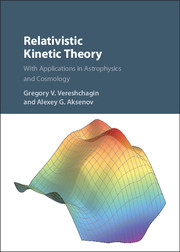Book contents
- Frontmatter
- Contents
- Preface
- Acknowledgments
- Acronyms and Definitions
- Introduction
- Part I Theoretical Foundations
- 1 Basic Concepts
- 2 Kinetic Equation
- 3 Averaging
- 4 Conservation Laws and Equilibrium
- 5 Relativistic BBGKY Hierarchy
- 6 Basic Parameters in Gases and Plasmas
- Part II Numerical Methods
- Part III Applications
- Appendix A Hydrodynamic Equations in Orthogonal Curvilinear Coordinates
- Appendix B Collision Integrals in Electron-Positron Plasma
- Appendix C Collision Integrals for Weak Interactions
- Bibliography
- Index
1 - Basic Concepts
from Part I - Theoretical Foundations
Published online by Cambridge University Press: 09 March 2017
- Frontmatter
- Contents
- Preface
- Acknowledgments
- Acronyms and Definitions
- Introduction
- Part I Theoretical Foundations
- 1 Basic Concepts
- 2 Kinetic Equation
- 3 Averaging
- 4 Conservation Laws and Equilibrium
- 5 Relativistic BBGKY Hierarchy
- 6 Basic Parameters in Gases and Plasmas
- Part II Numerical Methods
- Part III Applications
- Appendix A Hydrodynamic Equations in Orthogonal Curvilinear Coordinates
- Appendix B Collision Integrals in Electron-Positron Plasma
- Appendix C Collision Integrals for Weak Interactions
- Bibliography
- Index
Summary
In this chapter the evolution of basic concepts of KT, such as phase space and distribution functions, from nonrelativistic to special and general relativistic frameworks is outlined. The relation between mechanical and kinetic pictures is presented. The physical meaning of the one-particle distribution function is given, and its Lorentz invariance is demonstrated. Then the most useful macroscopic quantities, such as four-current, entropy four-flux, energy-momentum tensor, and hydrodynamic velocity, are obtained. These concepts are essential to proceed with the formulation of kinetic equations as well as to understand the relation between kinetic theory and hydrodynamics discussed in following chapters.
Nonrelativistic Kinetic Theory
In classical (nonrelativistic) mechanics a complete description of a system composed of N interacting particles is given by their N equations of motion. In non-relativistic KT one deals with a space of positions and velocities of these particles, called configuration space or the space of canonical variables: positions and momenta of particles, called the phase space M. Often this mechanical description can be formulated in the language of Hamilton equations, and then an equivalent description of the system is given by a function of time and 6N independent variables, defined on M. An equation can be formulated for this function, called the Liouville equation, that can be written in an apparently very simple form:
where the derivative is over time. Its complexity, however, is equivalent to the complexity of the original N-body problem, and in the majority of cases, it cannot be addressed directly.
A tremendous simplification occurs for such systems, where N is very large. One may define the s-particle distribution function (DF) of states depending on 6s variables with 1 ≤ s ≤ N and time by integrating out the remaining 6(N – s) degrees of freedom in. The hierarchy of integro-differential equations, which connects the s-particle DFs with the s + 1-particle ones, called the Bogolyubov-Born- Green-Kirkwood-Yvon (BBGKY) hierarchy, is obtained in this way. Among these s-particle DFs, the one-particle DF plays a central role in KT, as it describes the probability of finding the particle in a state with momentum in the range (p, p + d3p) and position in the range (x, x + d3x) at the moment t. The s-particle DFs describe joint probabilities, i.e., particle correlations.
- Type
- Chapter
- Information
- Relativistic Kinetic TheoryWith Applications in Astrophysics and Cosmology, pp. 9 - 15Publisher: Cambridge University PressPrint publication year: 2017



